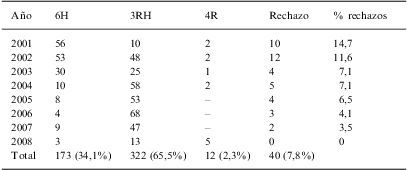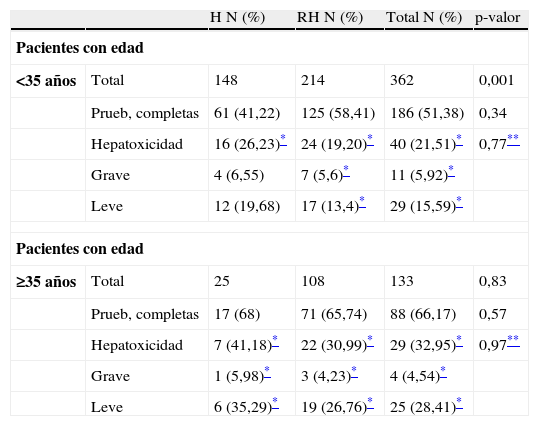La isoniacida (H) es la medicación de referencia utilizada para el tratamiento de la infección latente tuberculosa (ILT). La duración del tratamiento con H y su hepatotoxicidad suponen un serio obstáculo para su cumplimentación. En distintas guías clínicas se recomienda la pauta de 3 meses con rifampicina (R) e H como una alternativa aceptable a la de 6–9 meses con H. En el presente estudio presentamos nuestra experiencia con esta nueva pauta.
Pacientes y métodoA partir del año 2001 se empezó a ofertar la pauta de 3RH a los individuos mayores de 14 años, reclutados en el estudio de contactos. Se consideró buena adherencia cuando el paciente así lo manifestó y acudió a los controles mensuales programados. Se realizaron análisis hepáticos basales en aquellos pacientes que tenían riesgo de hepatotoxicidad y en todos los pacientes mayores de 35 años. En todos los casos se realizó un control hepático al primer mes de tratamiento y en cuanto presentaron síntomas de intolerancia. Se cruzaron las bases de datos de contactos y casos de tuberculosis para estimar el número de individuos que enfermaron de tuberculosis.
ResultadosEntre los años 2000–2008 se indicó tratamiento para la ILT en 547 contactos. El 7,8% rechaza el tratamiento, el 34,1% con la pauta de 6H, el 63,5% con la pauta de 3RH y el 2,3% a otras pautas. Un total de 84,97% (147/173) de los pacientes con la pauta de 6H y un 92,55% (302/322) con la pauta de 3RH completaron el tratamiento (p=0,024). Abandonaron por hepatotoxicidad el 2,37% (4/169) y el 1,6% (5/313) de los pacientes con pauta de 6H y 2RH, respectivamente (p=0,33). No hubo enfermos entre los pacientes que completaron el tratamiento en ninguna de las 2 pautas de estudio.
ConclusiónHubo una mayor adherencia (estadísticamente significativa) y menor hepatotoxicidad con la pauta de 3RH. Ambas pautas demostraron una total efectividad.
Isoniazid (I) is the drug of choice for treating latent tuberculous infection (LTI). Duration of treatment with I and its liver toxicity represent a serious drawback for a correct enforceability. In several clinical guides, a 3-month course with rifampicin (Rif) and I is recommended as an acceptable alternative to the 6–9 month course with I. Here we present our experience with this new regimen.
Patients and methodsFrom 2001, the 3-month regimenm with Rif and I was offered to patients older than 14 years, who were recruited in the contacts study. A good adherence was considered when the patient manifested so and he/she went to the scheduled monthly controls. We performed baseline liver analyses in those patients at risk of hepatotoxicity and in all patients older than 35 years. In all cases, a liver laboratory control was done at the first month of treatment and whenever patients had symptoms suggestive of intolerance. Databases of tuberculosis controls and contacts were crossed to evaluate the number of individuals who developed tuberculosis.
ResultsBetween 2000 and 2008, treatment for LTI was indicated in 547 contacts (7.8% refused treatment, 34.1% with the 6-month I course, 63.5% with the 3-month Rif and I course and 2.3% with other regimens). A total of 84.97% (147/173) patients with the 6-month I regimen and 92.55% (302/322) with the 3-month Rif and I course fulfilled the treatment (p=0,024). 2.37% (4/169) and 1.6% (5/313) patients with the 6-month I course and 3-month Rif and I course, respectively, withdrew because of hepatotoxicity (p=0,33). There were no patients among those who fulfilled the treatment in any of the 2 study arms.
ConclusionThere was a higher adherence (statistically significant) and lower hepatotoxicity with the 3-month Rif and I regimen. Both regimens showed a full effectivity.
Artículo
Comprando el artículo el PDF del mismo podrá ser descargado
Precio 19,34 €
Comprar ahora












